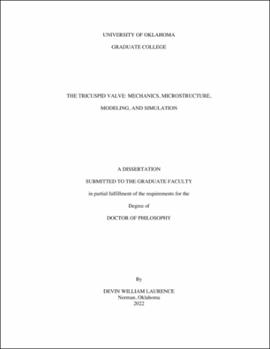| dc.description.abstract | The objectives of this research include: (1) experimentally characterizing the multi-scale properties of the tricuspid valve (TV) leaflets, (2) linking the mechanical and microstructural properties of the TV leaflets to their intrinsic microstructure and morphology, (3) developing new in-silico methods for modeling the TV leaflet mechanical behaviors, and (4) providing the first benchtop characterization and in-silico implementation of TV leaflet pre-strains.
We first characterize the properties of tricuspid valve leaflets at the tissue, mesoscale, and microstructural scales. The tricuspid valve leaflets are mechanically characterized using our established biaxial testing protocols to elucidate how the choice of specimen size influences the observed mechanical behaviors. Then, we employ our polarized spatial frequency domain imaging device to analyze the intrinsic collagen fiber architecture of each leaflet. Our results demonstrate that the leaflet mechanical behaviors are linked to the underlying collagen fiber architecture, which adapts to the applied loading. Finally, one representative specimen for each tricuspid valve leaflet is imaged using a confocal microscope with multiphoton imaging and second harmonic generation. From the resulting high-fidelity reconstructed microstructures, we note that the four layers of the tricuspid valve leaflets contains unique leaflet-specific arrangements of collagen and elastin fibers.
As an extension of the multi-scale characterizations, we then experimentally derive the contributions of the tricuspid valve leaflet microstructures to the tissue-level mechanical behaviors. First, the tricuspid valve leaflets are dissected into the composite atrialis/spongiosa layers and the composite fibrosa/venricularis layers. Our mechanical characterization revealed that the isolated composite layers were stiffer than the intact specimen. On the other hand, the mesoscale polarized spatial frequency domain imaging results show that the composite leaflet layers had more flexible collagen fiber architectures that reacted more to applied tensions than the intact specimens. Next, we use an iterative enzyme-digestion procedure to understand how the collagen fibers and elastin fibers contribute to the tricuspid valve leaflet mechanical. The collagen-digested leaflets were more compliant in their high-tensile mechanical behaviors due to the removal of the primarily load bearing constituent—collagen. In contrast, the elastin-digested specimens were significantly stiffer than the control specimens, suggesting that elastin may play an important role in mediating the recruitment of collagen fibers and the transition to the high-tensile mechanical behaviors.
We next shift our focus to in-silico developments and provide two new studies on modeling the mechanical behaviors of the tricuspid valve leaflets. In the first study, a constant invariant-based mechanical characterization is used to isolate the contributions of the first invariant and the fourth pseudo-invariant to the leaflet mechanical behaviors. These data are fit with three candidate strain energy density functions to evaluate their fitting efficacy. Our analyses reveal that an exponential strain energy density function is more suited for capturing the tricuspid valve leaflet mechanical behaviors. Interestingly, the coupling between the invariants is crucial to capturing the leaflet behaviors, and this must be considered in future constitutive modeling developments. For the second study, we focus on an emerging topic in the soft tissue biomechanics community: data-driven material modeling. This new approach is promising since it does not require the a priori definition of a constitutive law and instead relies on large collections of experimental data. We compare this emerging modeling technique with common structural constitutive models used for the atrioventricular heart valve leaflets and find that it provides excellent predictions of the leaflet behaviors provided sufficient model training data.
We conclude this dissertation by experimentally characterizing the tricuspid valve leaflet pre-strains, which are an important consideration when linking in vitro properties with in vivo function. First, the pre-strains of all three tricuspid valve leaflets are characterized using stereo cameras equipped with a direct linear transformation and the reproducing kernel shape function method. Our results reveal that there are indeed pre-strains embedded within the tricuspid valve leaflets that are released upon dissection of the tissue from their in-situ anatomy. In addition to the pre-strain quantification, we compare different stress-free reference configurations to determine which may provide mechanical behaviors closest to those in vivo. Interestingly, we found that our existing preconditioning method does not appropriately restore the in vivo leaflet behaviors as expected, and, instead, the post-preconditioned configuration results in stiffer, more anisotropic material behaviors. In the second portion of this investigation, we implement pre-strains into a simplified tricuspid valve finite element benchmark we develop to evaluate new computational methods. The finite element simulations reveal that the pre-strains significantly altered tricuspid valve behaviors: at 20% pre-strain, the leaflet stresses nearly doubled and there was the significant formation of valvular regurgitation. | en_US |

